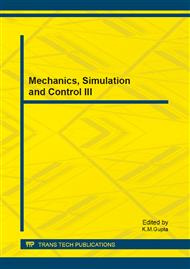[1]
S K Banala, S H Kim, S K Agrawal. Robot assisted gait training with active leg exoskeleton [J]. IEEE Transactions on Neural Systems and Rehabilitation Engineering, 2009, 17: 2-8.
DOI: 10.1109/tnsre.2008.2008280
Google Scholar
[2]
B Husemann, F Muller, C Krewer. Effects of locomotion training with assistance of a robot-driven gait orthosis in hemiparetic patients after stroke: A randomized controlled pilot study [J]. Stroke, 2007, 38: 349-354.
DOI: 10.1161/01.str.0000254607.48765.cb
Google Scholar
[3]
G B Prange, M J A Jannink, C G M Groothuis. Systematic review of the effect of robot-aided therapy on recovery of the hemiparetic arm after stroke [J]. Journal of Rehabilitation Research and Development, 2006, 43: 171-183.
DOI: 10.1682/jrrd.2005.04.0076
Google Scholar
[4]
G Kwakkel, B J Kollen, H I Krebs. Effects of robot-assisted therapy on upper limb recovery after stroke: A systematic review [J]. Neurorehabilitation and Neural Repair, 2008, 22: 111-121.
DOI: 10.1177/1545968307305457
Google Scholar
[5]
C L Lewis, D P Ferris. Invariant hip moment pattern while walking with a robotic hip exoskeleton [J]. Biomechanics, 2011, 44: 789-793.
DOI: 10.1016/j.jbiomech.2011.01.030
Google Scholar
[6]
M Noel, B Cantin, Lambert S. An electrohydraulic actuated ankle foot orthosis to generate force fields and to test proprioceptive reflexes during human walking [J]. IEEE Transactions Neural System Rehabilitation Engineering, 2008, 16(4): 390-399.
DOI: 10.1109/tnsre.2008.926714
Google Scholar
[7]
E Garcia, J C Arevalo, G Munoz. Combining series elastic actuation and magneto-rheological damping for the control of agile locomotion [J]. Robotics and Autonomous Systems, 2011, 59: 827-839.
DOI: 10.1016/j.robot.2011.06.006
Google Scholar
[8]
Y F Zheng, J Shen. Gait synthesis for the SD-2 biped robot to sloping surface [J]. IEEE Transactions on Robotics and Automation, 1990, 6 (1): 86-96.
DOI: 10.1109/70.88120
Google Scholar
[9]
S Kajita, K Tani. Experimental study of biped dynamic walking [A]. IEEE International Conference on Robotics and Automation, 1995, pp.2885-2895.
DOI: 10.1109/robot.1995.525693
Google Scholar
[10]
J Yamaguchi, N Kinoshita, A Takanishi. Development of a dynamic biped walking system for humanoid: development of a biped walking robot adapting to the humans living floor [A]. IEEE International conference on Robotics and Automation, 1996, pp.232-239.
DOI: 10.1109/robot.1996.503783
Google Scholar
[11]
R Boulic, N M Thalmann. A global human walking model with real-time kinematic personification [J]. Visual Computer, 1990, 6: 344-358.
DOI: 10.1007/bf01901021
Google Scholar
[12]
J Y Goulermas, D Howard, C J Nester. Regression techniques for the prediction of lower limb kinematics [J]. Journal of Biomechanical Engineering, 2005, 127: 1020–1024.
DOI: 10.1115/1.2049328
Google Scholar


